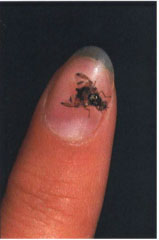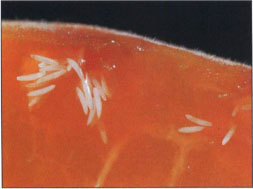All Issues
Medfly - going but not gone
Publication Information
California Agriculture 53(2):6-6.
Published March 01, 1999
PDF | Citation | Permissions
Full text
Mediterranean fruit flies lay their eggs in fruit and are a major threat to citrus and stone fruit. If the medfly became a permanent resident statewide, it could cost the state nearly $1.6 billion a year in crop loss and treatment, says entomologist Robert Dowell of the California Department of Food and Agriculture ( see p. 28 ). The state's Preventative Release Program for controlling medflies has greatly reduced - but not eliminated - infestations in Southern California.
First detected in California in 1975, medflies enter the state primarily through urban areas. In 1987, medflies began appearing in and around the Los Angeles Basin every year and in growing numbers. Initially, the CDFA dealt with infestations as they were found with treatments including spraying Malathion from helicopters.
In 1996, the CFDA established the Preventative Release Program (PRP), releasing at least 125,000 sterile medflies each week per square mile over a 2,155 square mile area of urban Southern California. The idea is that releasing so many sterile flies will mean that any wild flies out there will end up with sterile mates and so produce sterile eggs.
“It's a fantastic tool,” says Joseph Morse, director of the UC Center for Exotic Pest Research in Riverside. “There are no political drawbacks except for the cost. The public doesn't mind sterile flies the way they did aerial Malathion spraying.”
At $13 million per year, the PRP is not cheap. But the costs of program are far less than those that would be incurred if the medfly was permanently established in California.
So far, the PRP has reduced medfly infestations in the Los Angeles area by about 93%. However, there has been one medfly infestation in the PRP; 23 adult medflies were found in Walnut Park in 1997. Last year, there were three incidences of medflies outside the PRP: 72 were found in Lake Elsinore, Riverside County; 7 were found in La Jolla, San Diego County and 12 were found in Lake Forest, Orange County.
Making the PRP more effective will require learning more about the sterile insect technique, medfly mating behavior, and how to mass-rear flies in the laboratory to be more effective in preventing wild males from finding and mating with wild (introduced) females. Although the sterile insect technique has been used for a number of years (originally to eradicate the screwworm fly), there is still much to learn about how it works, says Morse. A major problem is that medflies reared for extended periods of time under laboratory conditions don't appear to be as competitive in the field as wild medflies. Research might lead to improved strains of sterile (or genetically engineered) flies which live longer, are more competitive, and could be released in lower numbers, making the technique more economical.
Another question that research could resolve is whether wild female medflies will eventually learn to stop mating with sterile males. Called behavioral resistance, this has happened in one population of wild medflies in Hawaii, where this exotic pest has been established since before 1900. Knowing what leads to behavioral resistance could help us figure out how to keep it from happening in California.
Research might also help us increase the field life of sterile medflies. Currently, they live only about 5 days after their release, far shorter than the up to 30-day lifespan of wild medflies. The problem is that the irradiation used to make the medflies sterile also makes them weak. Finding an alternative to radiation could also help solve the problem of behavioral resistance because irradiated flies are likely to be less competitive when it comes to mating.
“Female fruit flies are quite choosy—males have to go through a complex courtship behavior and that's probably asking a lot of these weakened sterile males,” says Morse.
By working together, UC, the CDFA and the USDA may be able to address some of these issues. “Research funding is limited and the incidence of exotic pests is rising,” says Morse. “There is a need and an opportunity for us all to work more closely.”






